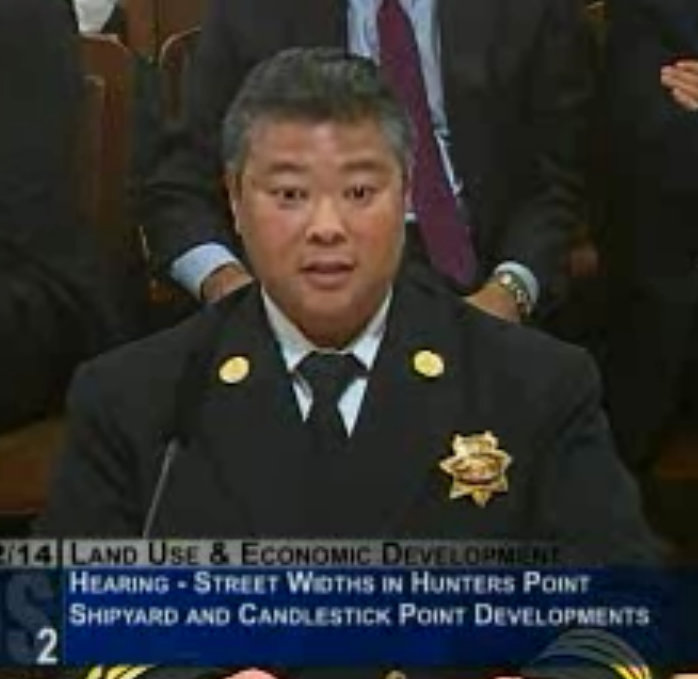The debate over whether San Francisco's streets should be wider and less safe just to accommodate fire trucks was aired publicly at a City Hall hearing yesterday. Livable streets advocates and Supervisor Scott Wiener, who called the hearing, challenged the SF Fire Department's insistence on wider roadways, particularly its recent eleventh-hour push to change street widths that were agreed upon years ago in redevelopments at Hunters Point Shipyard and Candlestick Point.
Officials from SFFD and the Department of Public Works asserted that dozens of miles of new residential streets planned in those redevelopments were not limited to 20 feet wide, as stipulated in city plans and agreements. Instead, they insisted that the roads must be expanded to 26 feet. Officials from the Office of Community Investment and Infrastructure (the successor to the SF Redevelopment Agency), the developers, and community members involved in the decades of planning for those projects all disagreed.
SFFD officials disregarded those agreements, as well as 20-foot minimums set in the state fire code -- the same width SFFD defended when it attempted to subvert new 12-foot minimums last year. Fire Marshal Michie Wong said the department prefers 26 feet because that's the standard set in the International Fire Code, even though city policies have set much lower minimums. Wong said SFFD has printed documents telling developers that the minimum street width under the Fire Code is 26 feet.
"We are imposing the authority to use whatever we need to justify the increased width," said Wong. Using the International Fire Code standard "as a guideline is sound judgment."
In response, Wiener said, "I have an issue when the legislative body that the voters have elected has chosen not to adopt a particular requirement, that the Fire Department would nevertheless impose that."
To make the department's case, SFFD Assistant Deputy Chief Ken Lombardi showed a presentation of photos and videos from fires in the city where they claimed limited space between parked cars made the job difficult, including the recent major construction fire in Mission Bay, and a similar one in Houston, Texas.
"Using the example of extreme [situations] does not help the conversation; it definitely escalates fear in people," said Cheryl Brinkman, who sits on the SFMTA Board of Directors but spoke only for herself. "I think we have more to fear every day from poorly-designed streets."
Wiener asked Lombardi if he also had photos of pedestrian crashes, which comprise a major chunk of SFFD's emergency responses. Lombardi said showing photos of victims was against the law, and noted that he spoke to the Pedestrian Safety Advisory Committee in January, where he admitted the department doesn't quite know what is delaying fire responses. "There could just be more cars," he said at the time.
Transportation planners like Ricardo Olea, the SFMTA's chief traffic engineer, presented data showing the exponential correlation between street width and driving speeds, which lead to traffic crashes in greater numbers and severity. A study done in Longmont, Colorado found that an increase in street width from 24 to 36 feet led to a 485 percent increase in injury crashes, on average.
"The general professional consensus has been that American streets were built too wide originally," said Olea. "It's important to get our new streets correct."
Fires "don't happen every day," but "street safety happens every day," said Allan Jacobs, the former head of the SF Planning Department, and an emeritus professor of city planning at UC Berkeley. Jacobs noted that the number of fire victims in the city is dwarfed by the number of pedestrian victims -- about three struck every day, with roughly two dozen killed each year.
"If the highest priority is fire safety, you'd end up with wider and wider streets," said Jacobs. "You lose housing. It'd be a less livable city."
Kofi Bonner, representing the developer at Hunters Point and Candlestick Point, said expanding the agreed-upon street widths would likely take space from sidewalks, rainfall-absorbing "bioswale" gardens, parks, and potentially residences.
"I thought we were beyond this," said Bonner, referring to the SFFD's push to change agreements set four years ago. "We can't afford to re-think this."
Pointing to the examples of construction fires cited by SFFD's Lombardi, Livable City Executive Director Tom Radulovich said there were numerous other fire safety measures to take other than simply widening the streets. For one, SFFD could ban car parking in front of construction sites where sprinklers have not yet been activated.
"Designing streets that [will be] overly wide for decades, just to deal with an issue that only happens during construction, is stupid," he said. Traffic violence "is the biggest public safety problem we have as a city," and narrower streets "are some of the city's best streets to live on."
"People who live in Hunters Point, or who live any part of this city, deserve to have great, walkable, complete streets," said Wiener.






